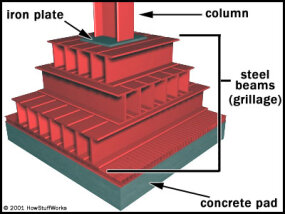

User Controls
Technologist believes the "official" 9/11 narrative
-
2019-09-24 at 11:37 PM UTC
-
2019-09-24 at 11:38 PM UTCThe following users say it would be alright if the author of this post didn't die in a fire!
-
2019-09-24 at 11:40 PM UTC
-
2019-09-24 at 11:41 PM UTC
-
2019-09-25 at 12:24 AM UTC
-
2019-09-25 at 1:05 AM UTC
-
2019-09-25 at 1:59 AM UTC
-
2019-09-25 at 1:59 AM UTC
-
2019-09-25 at 1:59 AM UTC
-
2019-09-25 at 2 AM UTC
-
2019-09-25 at 2 AM UTC
-
2019-09-25 at 5:59 AM UTC
Originally posted by -SpectraL "The WTC team took a slightly different approach. They decided to build long "tubes," where all the support columns would be around the outside of the building and at the central core of the building. Essentially, each tower was a box within a box, joined by horizontal trusses at each floor.
The outer box, measuring 208 feet by 208 feet (63x63 m), was made up of 14-inch (36-cm) wide steel columns, 59 per building face, spaced just over 3 feet (1 m) apart. On every floor above the plaza level, the spaces between the columns housed 22-inch (56-cm) windows. Yamasaki, who had a pronounced fear of heights, felt that the small windows made the building feel more secure. The columns were covered with aluminum, giving the towers a distinctive silver color. The inner box at the core of each tower measured about 135 feet by 85 feet (41x26 m). Its 47 heavy steel columns surrounded a large open area housing elevators, stairwells and restrooms.
This design had two major advantages. First of all, it gave the building remarkable stability. In addition to shouldering some of the vertical load (the weight of the building), the outer steel columns supported all of the horizontal forces acting on the tower (the force of the wind). This meant the inner support structure was completely dedicated to the huge vertical loads. The vertical support columns at the core of the building went all the way down below the bottom floor, through the basement structure, to the spread footing structure below ground. In the spread footing design, each support column rests directly on a cast-iron plate, which sits on top of a grillage. The grillage is basically a stack of horizontal steel beams, lined side by side in two or more layers (see diagram below). The grillage rests on a thick concrete pad poured on the solid bedrock deep underground. This pyramid shape distributes the concentrated weight from the columns over a wide, solid surface. With the steel in place, the entire structure was covered with concrete. Near the base of each tower, at the plaza level, the narrowly spaced perimeter support columns rested on "column trees." The arched column trees spread the weight from the narrowly spaced columns over thicker columns spaced about 10 feet (3 m) apart. Each of these columns rested on additional, smaller support footings in the foundation."

not really, no.
Diagram (above): Framed tube construction principle: load-bearing external walls stiffened by the floors to form a torsionally rigid tube
13 Load-bearing external wall
17 Core box column
20 Floor slab
Note that the buildings are stiffened by the composite steel-concrete floors. The floors are an integral part of the structural system. Without the composite floor slabs, the buildings would soon collapse.
The wall thickness and grade of steel in the external columns are varied in successive steps in the upward direction: wall thickness decreasing from 12.5 to 7.5 mm, yield point of the steel from 70.0 to 29.5 kg/mm2. To ensure that the floors remain plane, i.e., free from warping distortion, the external columns are so designed that the stresses, and therefore the strains, produced in them by vertical loads are equal to those produced in core columns (mild steel with yield point of 24 kg/mm2). The reserve stress capacity in the external columns which is provided by the progressively graded qualities of steel serves to absorb wind load. The design value adopted for wind pressure over the entire height of the building is 220 kg/in2. The calculated maximum deflection at the top of the building is 28 cm.
essentially the towers are like fleshlights, hard on the outside, soft and hollowed at the center. -
2019-09-25 at 6:49 AM UTCResistance would of slowed a collapse. It had a 5 times redundancy of what weight the building had carried. A partial collapse of warped trusses makes sense but this fucker banana peeled most of its weight outward. Made zero fucking sense. A mysterious energy tearing it to shreds like a fucking paper shredder eating 8x11" pages of Paper.The following users say it would be alright if the author of this post didn't die in a fire!
-
2019-09-25 at 7:39 AM UTC
Originally posted by Mud Hole Mania Resistance would of slowed a collapse. It had a 5 times redundancy of what weight the building had carried. A partial collapse of warped trusses makes sense but this fucker banana peeled most of its weight outward. Made zero fucking sense. A mysterious energy tearing it to shreds like a fucking paper shredder eating 8x11" pages of Paper.
Not in a pancaking collapse scenario. The upper floors fell and hit the lower floors like a hammer. -
2019-09-25 at 7:43 AM UTC
-
2019-09-25 at 4:19 PM UTC
Originally posted by Star Trek VI: The Undiscovered Country Not in a pancaking collapse scenario. The upper floors fell and hit the lower floors like a hammer.
The building peeled outward with most of the material ejecting outward on all 4 sides, the outer steel beams was a mesh that was pierced and torn outwards while 47 columns welded in a concrete casing along with steel elevator shafts just disintegrated
Pancaking would of been caused by kinetic energy. Even NIST finally stated that this was not the cause after it updated its report. -
2019-09-25 at 4:22 PM UTCGravity pulls down and not out..xyz axis points all failed. In order for this to happen in the most basic fundamental laws of physics is if there is an external force greater than force not in motion or resisting forces.
-
2019-09-25 at 6:13 PM UTC
Originally posted by Mud Hole Mania Resistance would of slowed a collapse. It had a 5 times redundancy of what weight the building had carried. A partial collapse of warped trusses makes sense but this fucker banana peeled most of its weight outward. Made zero fucking sense. A mysterious energy tearing it to shreds like a fucking paper shredder eating 8x11" pages of Paper.
Originally posted by Star Trek VI: The Undiscovered Country Not in a pancaking collapse scenario. The upper floors fell and hit the lower floors like a hammer.
thats not how fluid dynamic works.
the floor failed from the center out, so it convexed/concaved and so the tower collapsed in a conical / parabolical shape down, amd ejecting gasses and materials sideway as the core came down first trailled by the side as gushes of what people called "explosions".
||||||||||||||
|\\\\\\//////|
|-\\\\\/////-|
|--\\\\////--|
|---\\\///---|
|----\\//----|
|-----\/-----|
|------------|
|------------| -
2019-09-25 at 8:36 PM UTC
Originally posted by Mud Hole Mania Resistance would of slowed a collapse. It had a 5 times redundancy of what weight the building had carried. A partial collapse of warped trusses makes sense but this fucker banana peeled most of its weight outward. Made zero fucking sense. A mysterious energy tearing it to shreds like a fucking paper shredder eating 8x11" pages of Paper.
Absolutely. But willful and determined idiots are way too stupid to figure this out.The following users say it would be alright if the author of this post didn't die in a fire! -
2019-09-26 at 3:36 AM UTC